AUDI Q5 2016 Owners Manual
Manufacturer: AUDI, Model Year: 2016, Model line: Q5, Model: AUDI Q5 2016Pages: 300, PDF Size: 75.02 MB
Page 241 of 300
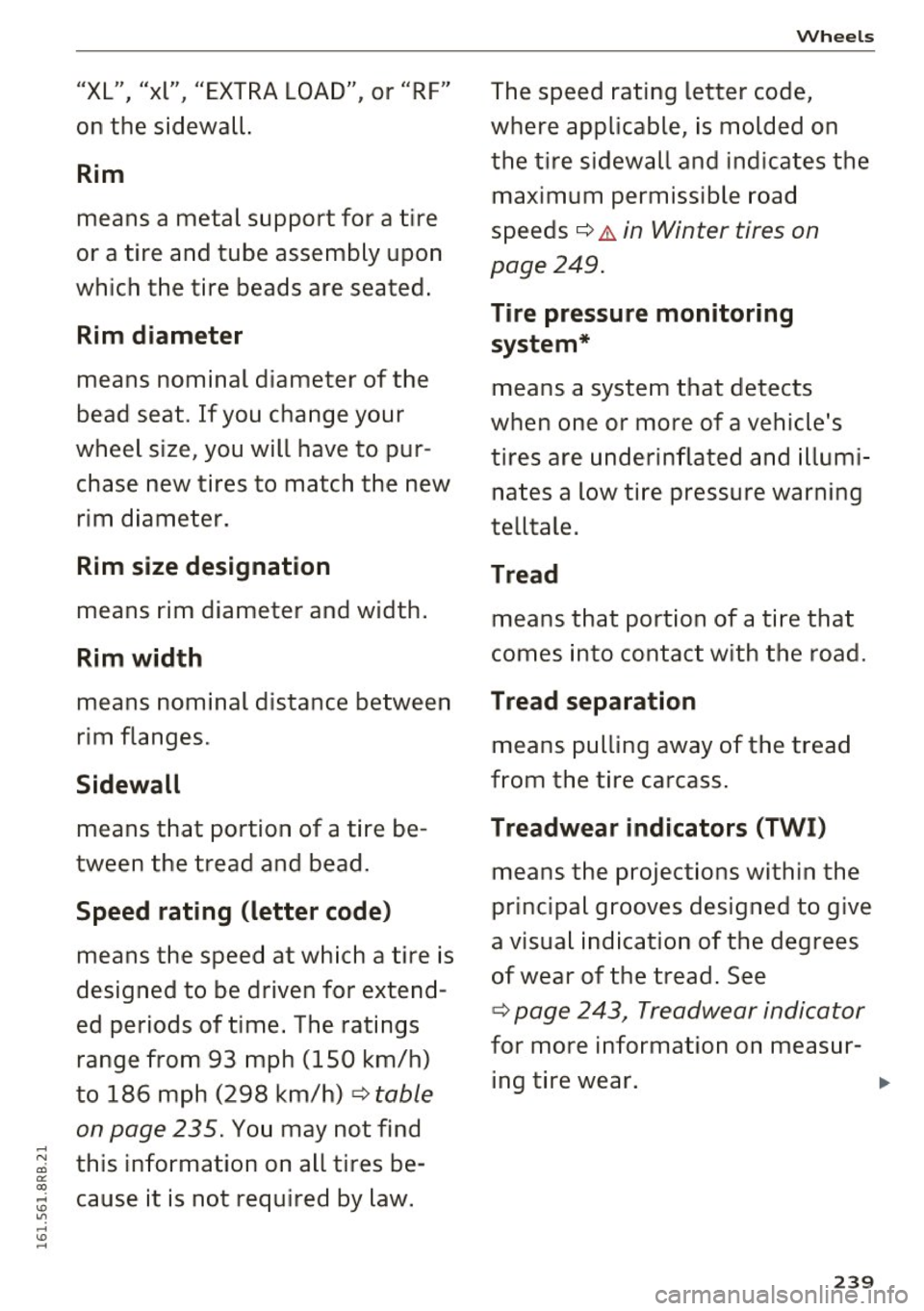
"XL" "xl" "EXTRA LOAD" or "RF" ' ' '
on the sidewall.
Rim
means a metal support for a tire
or a tire and tube assembly upon
which the tire beads are seated .
Rim diameter
means nominal diameter of the
bead seat. If you change your
wheel size, you will have to pur
chase new tires to match the new
rim d iameter.
Rim size designation
means rim diameter and width.
Rim width
means nominal distance between
r im flanges.
Sidewall
means that portion of a tire be
tween the tread and bead .
Speed rating (letter code )
means the speed at wh ich a tire is
designed to be driven for exten d
ed periods of t ime . The ratings
range from 93 mph (150 km/h)
to 186 mph (298 km/h)
¢ table
on page 235.
Yo u may not find
this information on all tires be
cause it is not required by law.
Wheels
T he speed rating letter code,
where applicable, is molded on
the tire sidewall and indicates the
maximum pe rmissible road
speeds
¢ & in Winter tires on
page 249 .
Tire pressure monitoring
system*
means a system that detects
when one or more of a vehicle's
tires are underin flated and illum i
na tes a low tire pressure wa rning
telltale.
Tread
means that port ion of a tire that
comes into contact with the road.
Tread separation
means pulling away of the tread
from the tire carcass .
Treadwear indicators (TWI)
means the projections within the
principal grooves designed to give
a visua l indication of t he degrees
of wear of the tread . See
¢ page 243, Treadwear indicator
for mo re info rma tion on measu r-
ing tire wear. .,.
239
Page 242 of 300
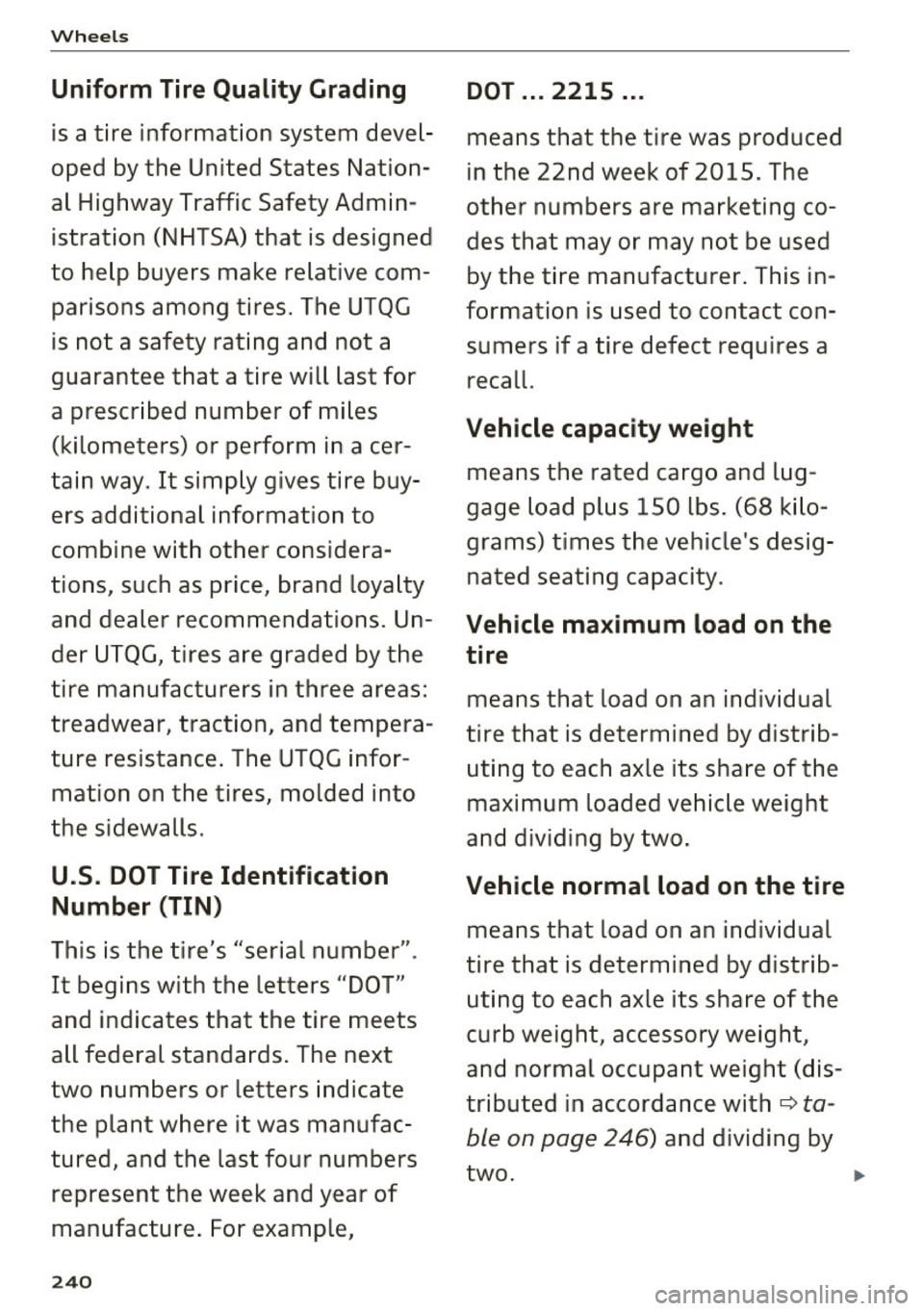
Wheels
Uniform Tire Quality Gr ading
is a tire information system devel
oped by the United States Nation
al Highway Traffic Safety Admin
istration (NHTSA) that is designed
to help buyers make relative com parisons among tires. The UTQG
is not a safety rating and not a
guarantee that a tire will last for
a prescr ibed number of miles
(kilometers) or perform in acer
tain way. It simply gives tire buy
ers additional information to
combine with other considera
tions, such as price, brand loya lty
and dealer recommendations. Un
der UTQG, tires are graded by the
tire manufacturers in three areas:
treadwear , traction, and tempera
ture resistance . The UTQG in for
mation on the tires, molded into
the sidewalls.
U.S. DOT Tire Identification
Number (TIN)
This is the tire's "serial number" .
It begins with the letters "DOT"
and indicates that the tire meets
all federal standards. The next
two numbers or letters indicate
the plant where it was manufac
tured, and the last four numbers represent the
week and year of
manufacture . For example,
24 0
DOT ... 2215 ...
means that the tire was produced
in the 22nd week of 201 5. The
other numbers are marketing co
des that may o r may not be used
by the tire manufacturer . This in
formation is used to contact con sumers if a tire defect requires a
recall.
Veh icle capac ity weight
means the rated ca rgo and lug
gage load pl us 150 lbs . (68 k ilo
grams) times the vehicle's desig
nated seating capacity .
Vehicle maximum load on the
tire
means that load on an ind ividual
tire that is determined by distrib
uting to each axle its sha re of the
maximum loaded veh ic le we ight
and dividing by two.
Vehicle normal load on the tire
means that load on an individual
tire that is determi ned by distrib
uting to each axle its share of the
curb weight, accessory weight,
and normal occupan t weight (dis
tributed in accordance with
c::> ta
ble on page 246) and dividing by
two .
~
Page 243 of 300
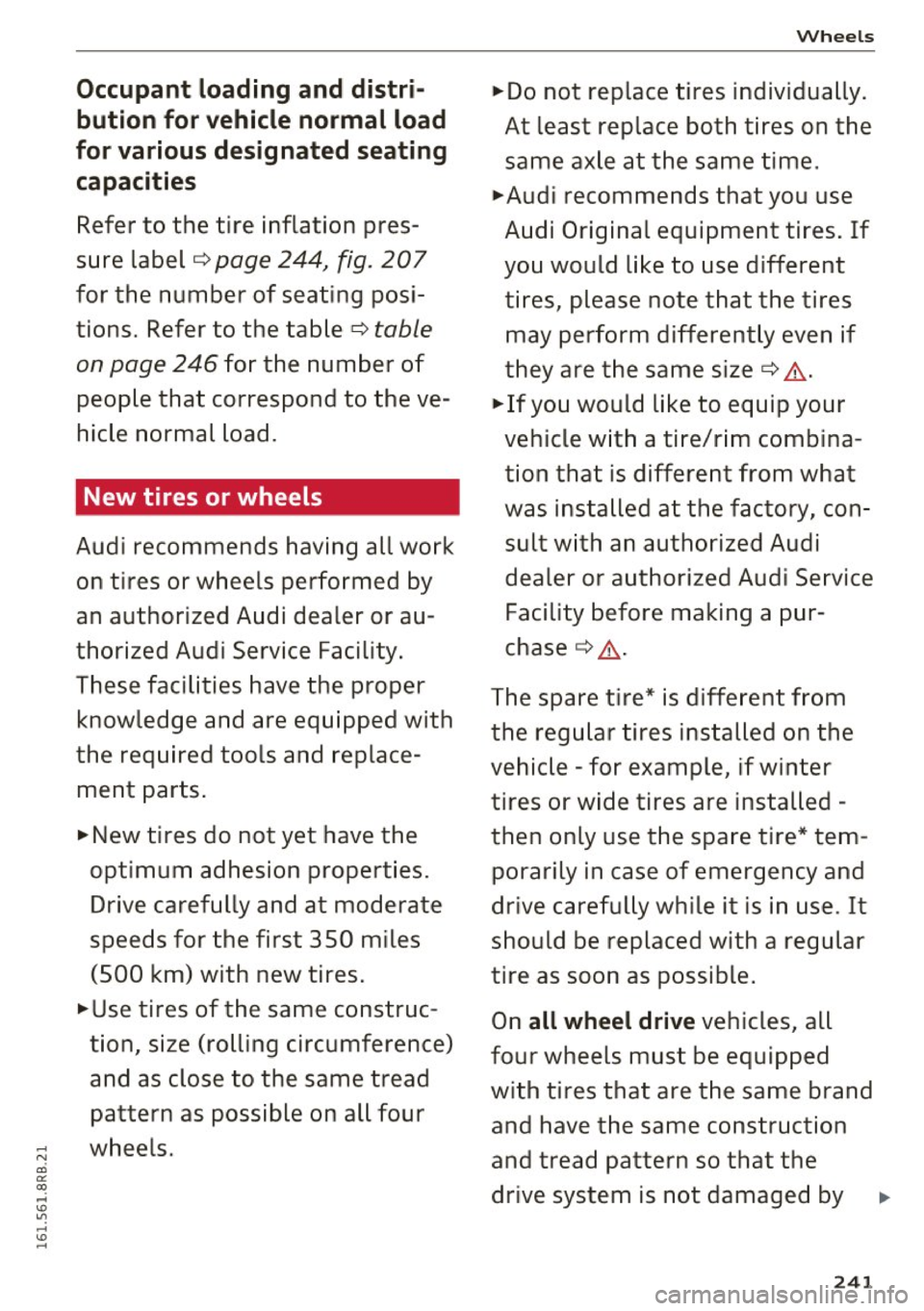
Occupant loading and distri
but ion for vehicle normal load
for various design ated se ating
c a pa cit ies
Refer to the tire inflation pres
sure label ¢
page 244, fig. 207
for the number of seating posi
tions. Refer to the table ¢
table
on page 246
for the number of
people that correspond to the ve
hicle normal load.
New tires or wheels
Audi recommends having all work
on tires or wheels performed by
an authorized Audi dealer or au
thorized Audi Service Facility .
These facilities have the proper
knowledge and are equ ipped with
the required tools and replace
ment parts .
.,,. New tires do not yet have the
opt imum adhesion properties.
Drive carefully and at moderate
speeds for the first 350 m iles
(500 km) with new tires .
... use tires of the same construc
tion, size (rolling circumference)
and as close to the same tread pattern as possible on all four
wheels.
Wheels
.,,. Do not replace tires individually.
At least replace both tires on the same axle at the same time .
.,,. Audi recommends that you use
Audi Original equipment tires. If
you would like to use different
tires, please note that the tires may perform differently even if
they are the same size¢,&..
.,,. If you would like to equip your
vehicle w ith a tire/r im combina
tion that is different from what
was installed at the factory, con
sult w ith an authorized Audi
dealer or authorized Audi Service
Facility before making a pur
chase ¢
..1,..
The spare t ire* is diffe rent from
the regular tires installed on the
vehicle - for example, if winter
tires or wide tires are installed -
then only use the spare tire* tem
porarily in case of emergency and
drive carefully while it is in use . It
should be replaced with a regular
tire as soon as possible.
On
all wheel d rive vehicles, all
four wheels must be equipped
with tires that are the same brand
and have the same construction
and tread pa ttern so that the
drive system is not damaged by
24 1
Page 244 of 300
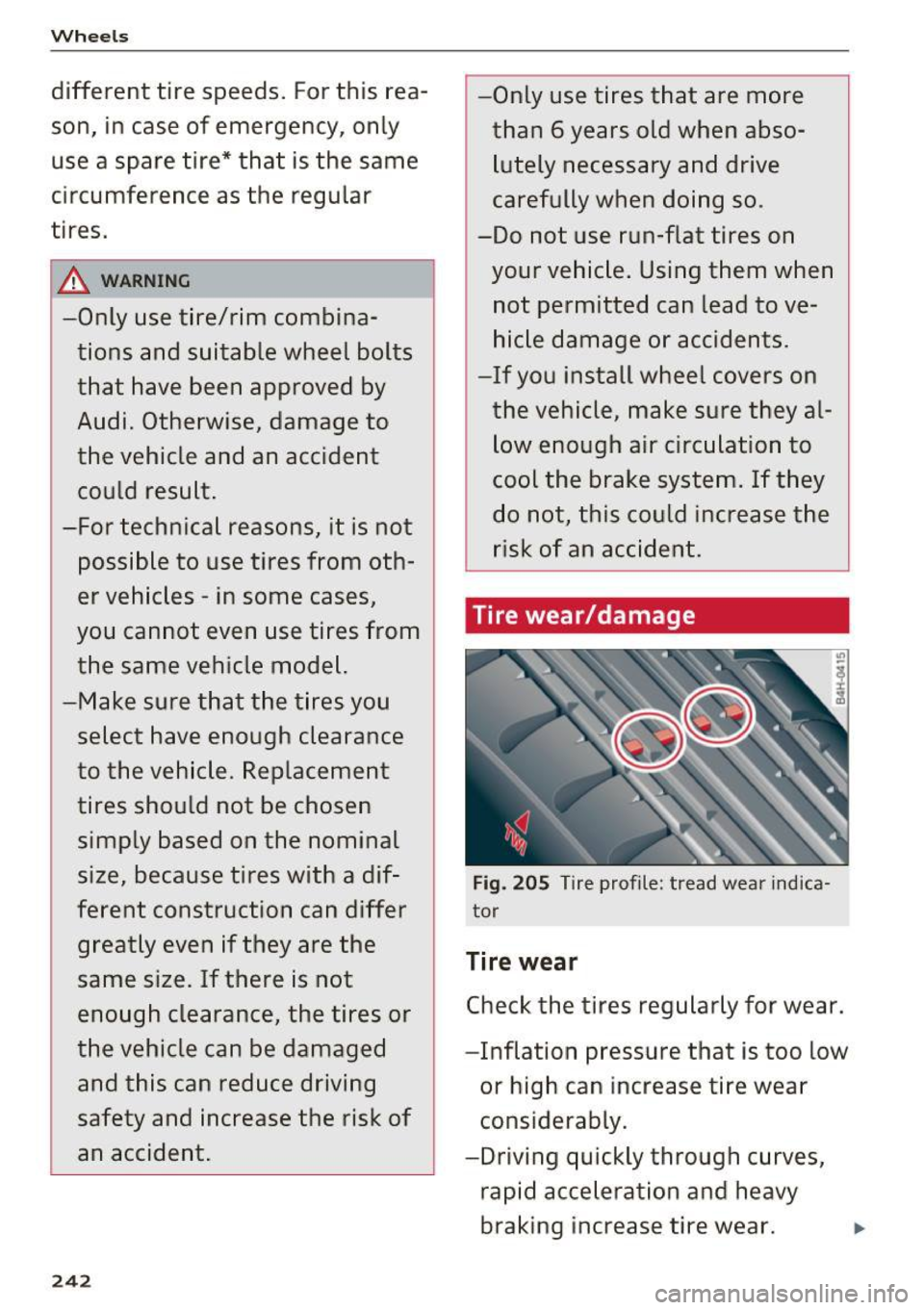
Wheels
different tire speeds. For this rea
son, in case of emergency, only
use a spare tire* that is the same
circumference as the regular
tires.
,&. WARNING -
-Only use tire/rim combina tions and suitable wheel bolts
that have been approved by
Audi. Otherwise, damage to
the vehicle and an accident could result.
-For technical reasons, it is not possible to use tires from oth
er vehicles - in some cases,
you cannot even use tires from the same vehicle model.
-Make sure that the tires you select have enough clearance
to the vehicle . Replacement
tires should not be chosen simply based on the nominal
size, because t ires with a dif
ferent construction can differ
greatly even if they are the
same size. If there is not
enough clearance, the tires or
the vehicle can be damaged and this can reduce driving
safety and increase the risk of
an accident.
242
-Only use tires that are more
than 6 years old when abso
lutely necessary and drive
carefully when doing so .
-Do not use run-flat tires on your vehicle. Using them when not permitted can Lead to ve
hicle damage or accidents.
- If you install wheel covers on
the vehicle, make sure they al
low enough air circulation to
cool the brake system. If they
do not, this could increase the
risk of an accident.
Tire wear/damage
Fig. 205 Tire profile: tread wear ind ica
tor
Tire wear
Check the tires regularly for wear.
- Inflation pressure that is too Low
or high can increase tire wear
considerably.
-Driving quickly through curves, rapid acceleration and heavy
braking increase tire wear. ..
Page 245 of 300
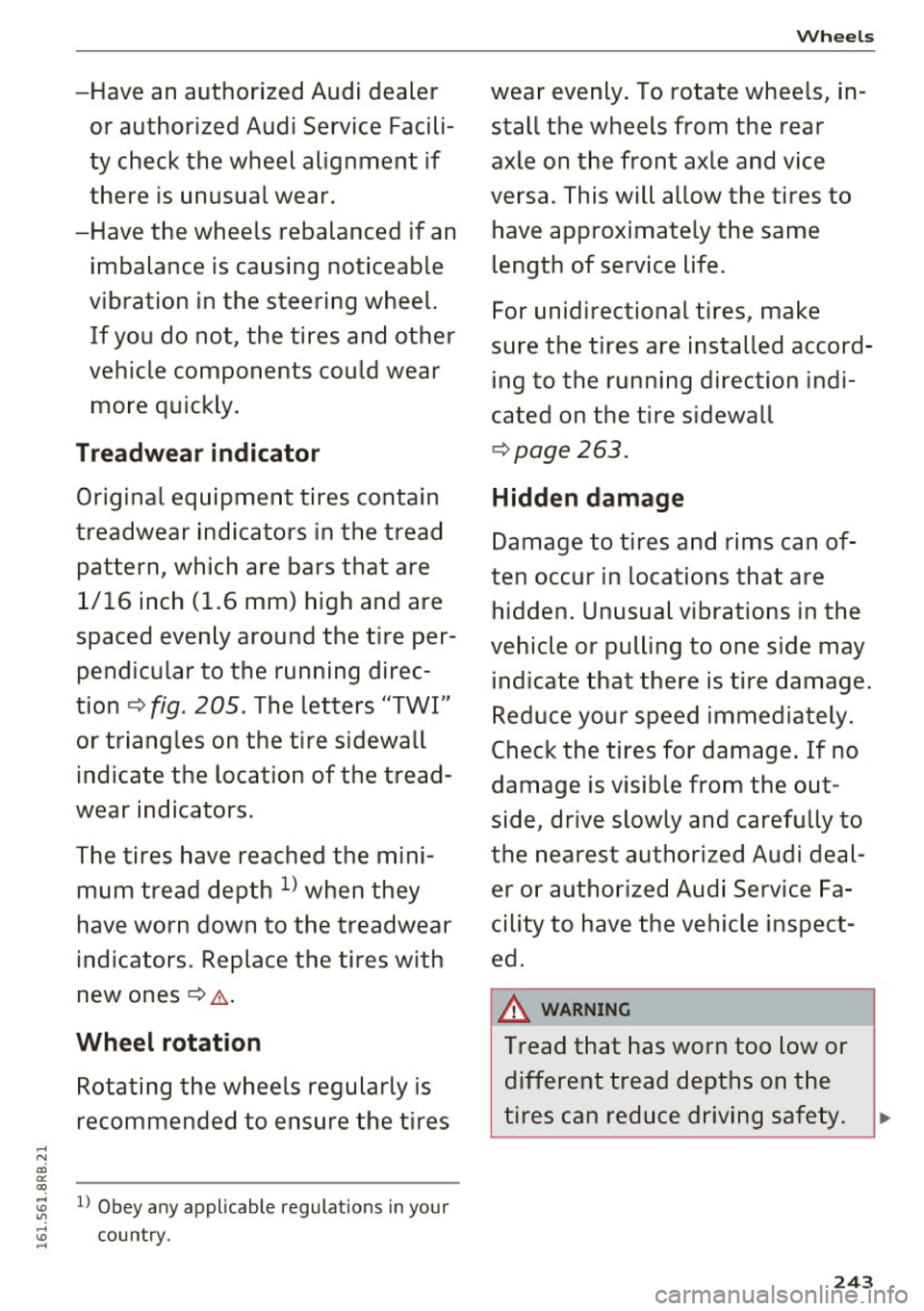
Wheels
-Have an authorized Audi dealer wear evenly. To rotate wheels, in-
or authorized Audi Service Facili- stall the wheels from the rear
ty check the wheel alignment if axle on the front axle and vice
there is unusual wear. versa. This will allow the tires to
-Have the wheels rebalanced if an have approximately the same
imbalance is causing noticeable length of service life.
vibration in the steering wheel. For unidirectional tires, make
If you do not, the tires and other sure the tires are installed accord-
vehicle components could wear ing to the running direction indi-
more quickly. cated on the tire sidewall
Treadwear indicator ¢page 263.
Original equipment tires contain Hidden damage
treadwear indicators in the tread
Damage to tires and rims can of-
pattern, which are bars that are ten occur in locations that are
1/16 inch (1 .6 mm) high and are
hidden. Unusual vibrations in the
spaced evenly around the tire per- vehicle or pulling to one side
may
pendicular to the running di rec-indicate that there is tire damage.
tion ¢
fig. 205. The letters "TWI"
Reduce your speed immediately .
or triangles on the tire sidewall Check the tires for damage. If no
indicate the location of the tread- damage is visible from the out-
wear indicators. side, drive slowly and carefully to
The tires have reached the mini- the nearest authorized Audi deal-
mum tread depth
l) when they er or authorized Audi Service Fa-
have worn down to the treadwear cility to have the vehicle inspect-
indicators . Replace the tires with ed.
new ones¢ &.
& WARNING
-
Wheel rotation Tread that has worn too low or
Rotating the wheels regularly is different tread depths on the
recommended to ensure the tires tires can reduce driving safety
.
..
.... N a:i er ~ ... l) Obey any applicable regu lat ions in your '° "? .... country . '° ...
243
Page 246 of 300
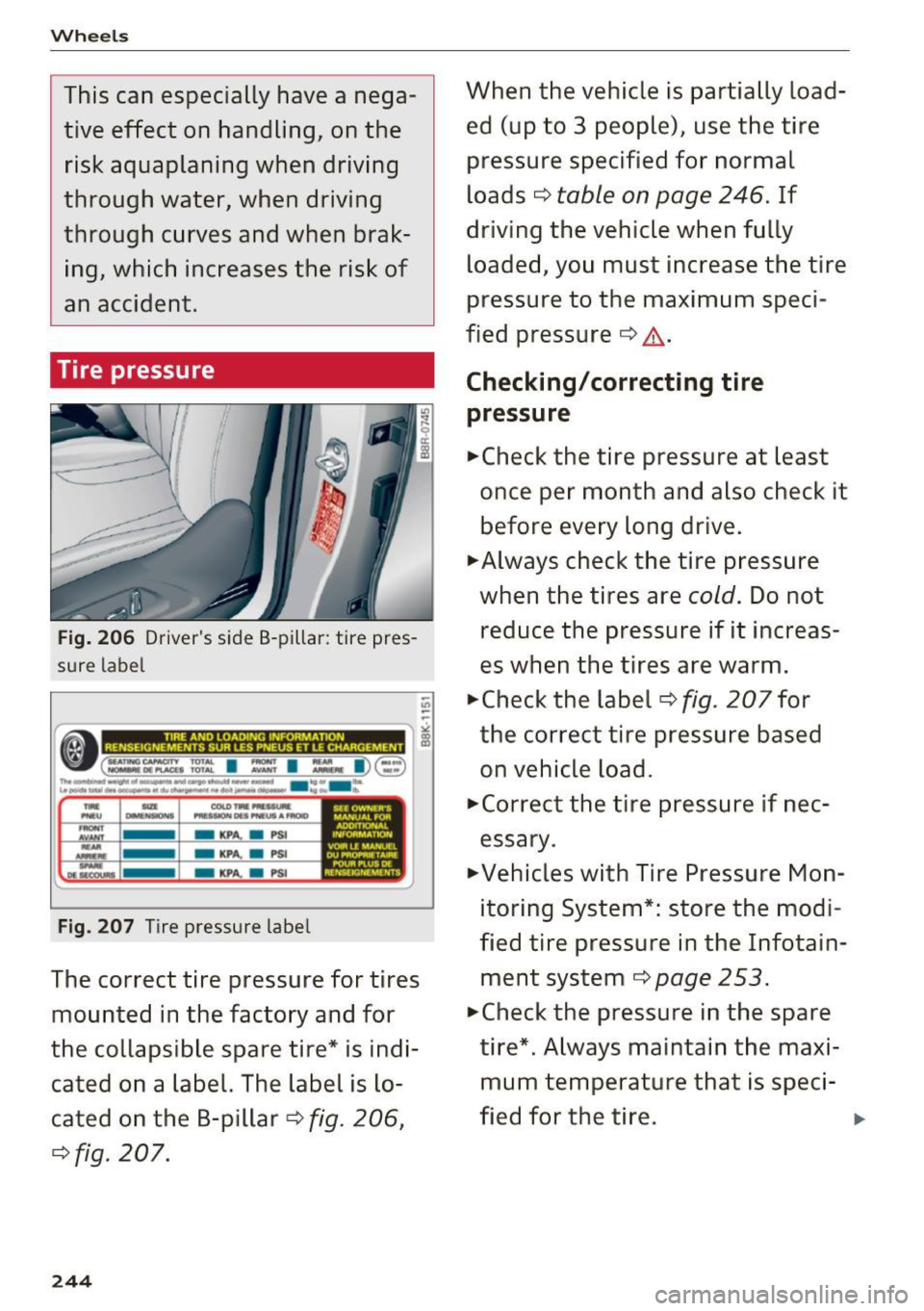
Wheels
This can especially have a nega
t ive effect on handling, on the
risk aquaplaning when driving
through water, when driving
through curves and when brak ing, which increases the risk of
an accident.
Tire pressure
Fig. 206 Driver's side 8-pillar: tire pres
sure label
-"' -r,...-------------~
• c==. ~:t I :'.!: I :,. 1) § l il! ................. .._.. ....................... .... . .. , '--................................ ,............ .... -.
TN 11D COt..O TN Nl&AUM. ,_U ~ ,,,...,..00,....AMOID
- KP aPSt
- KPA. a PSI
- KPA. a PSl
Fig. 207 Tire pressure label
SIE OWNl:llt'S MAN UAL FOR AD0010NAl 1NfOAMAT101-4 ~l[M.ANUCL DU PMCM"M T Al!IJ[ POW. ,tU$ Dl MNSC.JONlMtNTS
The correct tire pressure for tires
mounted in the factory and for
the collapsible spare tire* is indi
cated on a label. The label is lo
cated on the 8-pillar ¢
fig. 206,
¢fig. 207.
244
When the vehicle is partially load
ed (up to 3 people), use the tire pressure specified for normal
loads ¢
table on page 246. If
driving the vehicle when fully loaded, you must increase the tire
pressure to the maximum speci
fied pressure
i=> ,&. .
Checking/correcting tire
pressure
.,.Check the tire pressure at least
once per month and also check it
before every long drive .
.,.Always check the tire pressure
when the tires are
cold. Do not
reduce the pressure if it increas
es when the tires are warm.
.,.Check the label¢
fig. 207 for
the correct tire pressure based
on vehicle load .
.,.Correct the tire pressure if nec
essary.
.,.Vehicles with Tire Pressure Mon
itoring System*: store the modi
fied tire pressure in the Infotain
ment system
¢ page 253 .
.,.Check the pressure in the spare
tire*. Always maintain the maxi mum temperature that is speci-
fied for the tire. ..,
Page 247 of 300
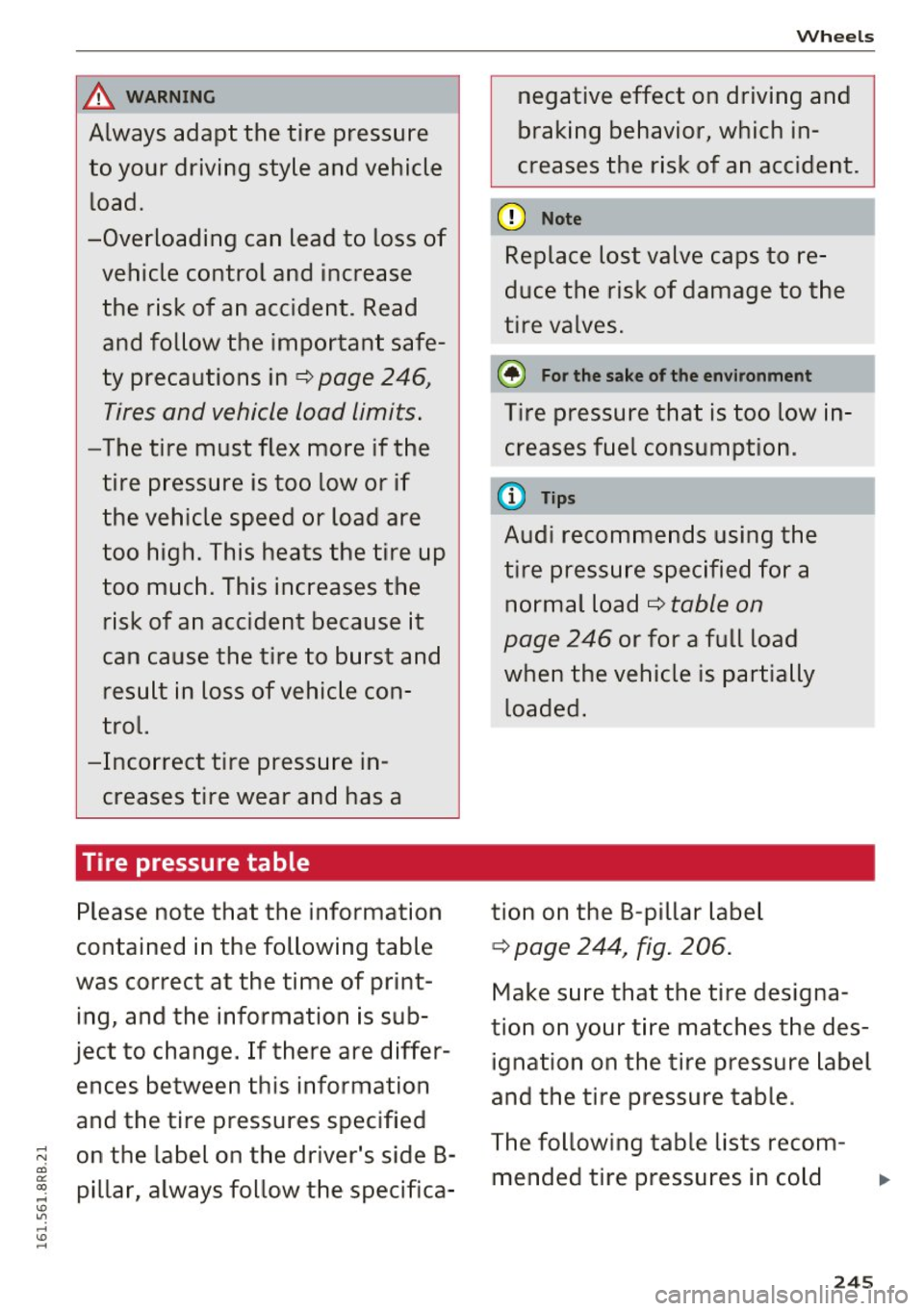
A WARNING
Always adapt the tire pressure
to your driving style and vehicle load.
-Overloading can lead to loss of
vehicle control and increase the risk of an accident. Read
and follow the important safe
ty precautions in¢
page 246,
Tires and vehicle load limits.
-The tire must flex more if the
tire pressure is too low or if
the vehicle speed or load are
too high. This heats the tire up
too much. This increases the risk of an accident because it
can cause the tire to burst and result in loss of vehicle con
trol.
-Incorrect tire pressure in creases tire wear and has a
Tire pressure table
Please note that the information
contained in the following table
was correct at the time of print
ing, and the information is sub
ject to change. If there are differ
ences between this information
and the tire pressures specified
on the label on the driver's side B pillar, always follow the specifica-
Wheels
negative effect on driving and
braking behavior, which in
creases the risk of an accident.
Replace lost valve caps to re
duce the risk of damage to the
tire valves.
@ For the sake of the environment
Tire pressure that is too low in
creases fuel consumption.
(1) Tips
Audi recommends using the
tire pressure specified for a normal load ¢
table on
page 246
or for a full load
when the vehicle is partially
loaded.
tion on the B-pillar label
¢ page 244, fig. 206.
Make sure that the tire designa
tion on your tire matches the des ignation on the tire pressure label
and the tire pressure table.
The following table lists recom mended tire pressures in cold
245
Page 248 of 300
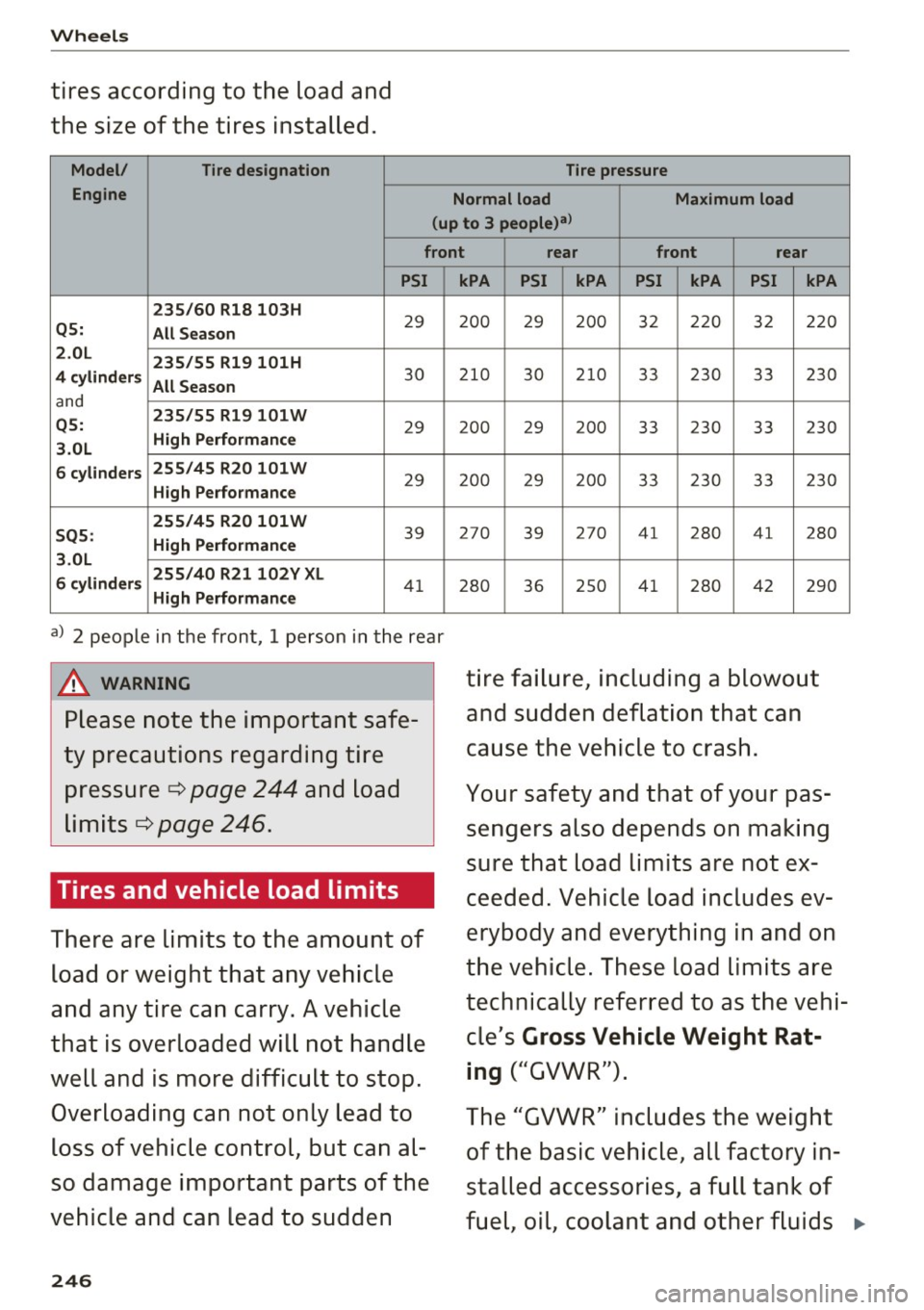
Wheels
tires according to the load and
the size of the tires installed.
Model/ Tire designation
Engine Tire pressure
Normal load Maximum load
(up to 3 people)al
front rear front rear
PSI
235/60 Rl8 103H
29 Q5:
All Season
2 .0L
235/55 R19 101H
4 cylinders All Season
30
and
Q5: 235/55 R19101W 29 High Performance
3.0L
6 cylinders 255/45
R20 101W
29 High Performance
255/45 R20 101W
39 SQ5: High Performance
3.0L
6 cylinders 255/40
R21102Y XL
41 High Performance
a) 2 people in the front, 1 person in the rear
A WARNING
Please note the important safe
ty precautions regarding tire pressure ¢
page 244 and load
limits ¢
page 246.
Tires and vehicle load limits
There are limits to the amount of
load or weight that any vehicle
and any tire can carry. A vehicle
that is overloaded will not handle
well and is more difficult to stop.
Overloading can not only lead to
loss of vehicle control, but can al
so damage important parts of the
vehicle and can lead to sudden
246
kPA PSI kPA PSI kPA PSI kPA
200 29 200 32 220 32 220
210
30 210 33 230 33 230
2 00 29 2 00 33 2 30 33 230
200 29 200 33 230 33 230
27 0
39 27
0 41 2 80 41 2 80
280 36 250 4 1 280 42 290
tire failure, including a blowout
and sudden deflation that can
cause the vehicle to crash.
Your safety and that of your pas
sengers also depends on making
sure that load limits are not ex
ceeded. Vehicle load includes ev
erybody and everything in and on
the vehicle. These load limits are
technically referred to as the vehi
cle's
Gross Vehicle Weight Rat
ing
("GVWR").
The "GVWR" includes the weight
of the basic vehicle, all factory in
stalled accessories, a full tank of
fuel, oil, coolant and other fluids ..,.
Page 249 of 300
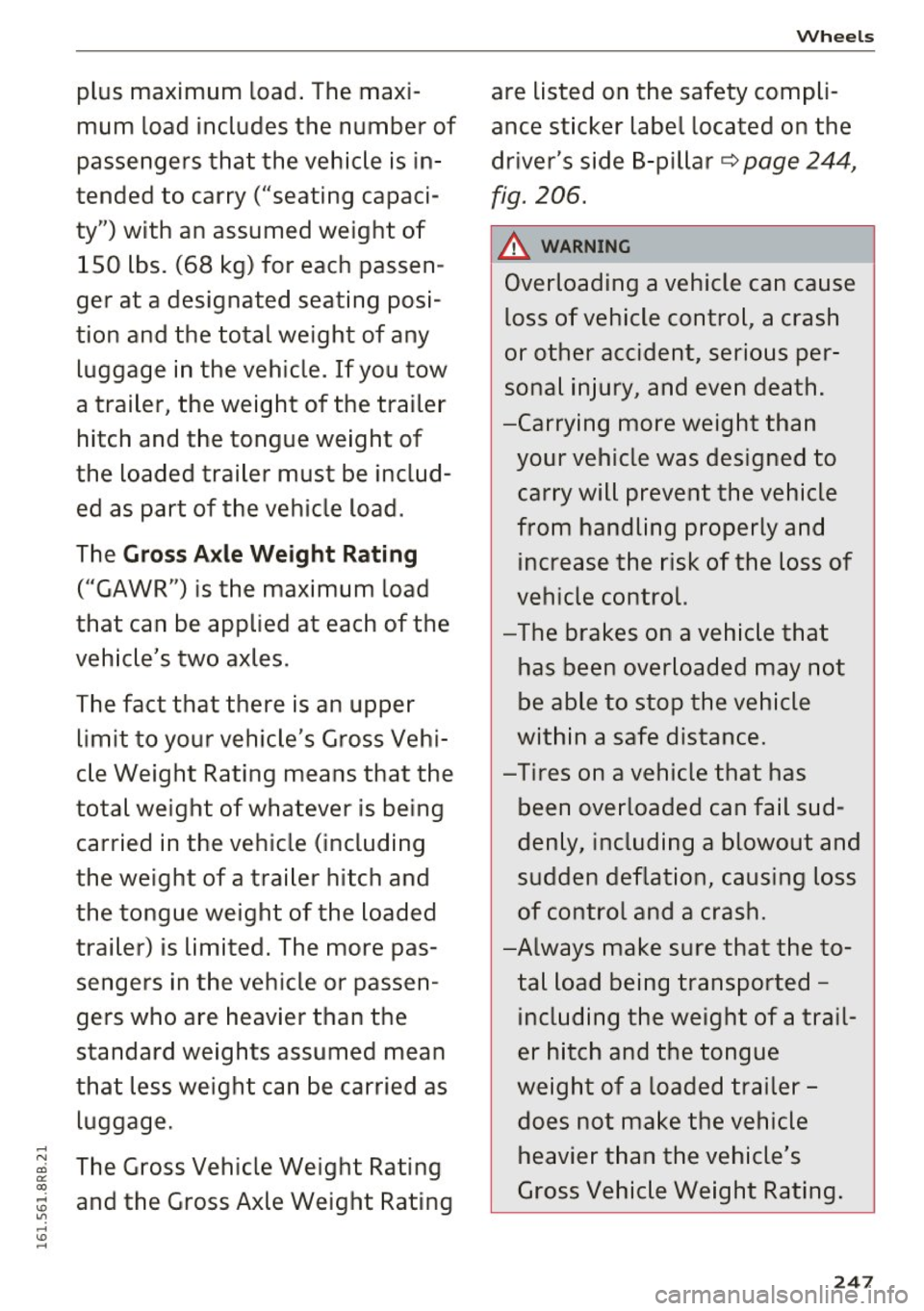
plus maximum load. The maxi
mum load includes the number of
passengers that the vehicle is in
tended to carry ("seating capaci
ty") with an assumed weight of
150 lbs. (68 kg) for each passen
ger at a designated seating posi
tion and the total weight of any luggage in the vehicle . If you tow
a trailer, the weight of the trailer
hitch and the tongue weight of
the loaded trailer must be includ
ed as part of the vehicle load .
The
Gross A xle Weight Rating
("GAWR") is the maximum load
that can be appl ied at each of the
vehicle's two axles.
The fact that there is an upper
limit to your vehicle's Gross Vehi
c le Weight Rating means that the
total weight of whatever is being
carried in the vehicle (including
the weight of a tra iler hitch and
the tongue weight of the loaded
trailer) is limited. The more pas
sengers in the vehicle or passen
gers who are heavier than the
standard weights assumed mean
that less weight can be carried as luggage.
The Gross Vehicle We ight Rating
and the Gross Axle Weight Rating
Wheels
are listed on the safety compli
ance sticker label located on the
driver's side B -pillar
¢ page 244,
fig . 206.
_& WAR NING
Overloading a vehicle can cause
loss of vehicle control, a crash
or other accident, serious per
sonal in jury, and even death.
-Carrying more weight than
your vehicle was designed to carry will prevent the vehicle
from handling properly and increase the risk of the loss of
vehicle control.
- The brakes on a vehicle that
has been overloaded may not
be able to stop the vehicle
within a safe distance.
-Tires on a vehicle that has
been overloaded can fail sud
denly, including a blowout and
sudden deflation, causing loss
of control and a crash.
-Always make sure that the to
tal load being transported -
including the weight of a trail
er hitch and the tongue
weight of a loaded trailer - does not make the vehicle
heavier than the vehicle's
Gross Vehicle Weight Rating .
247
Page 250 of 300
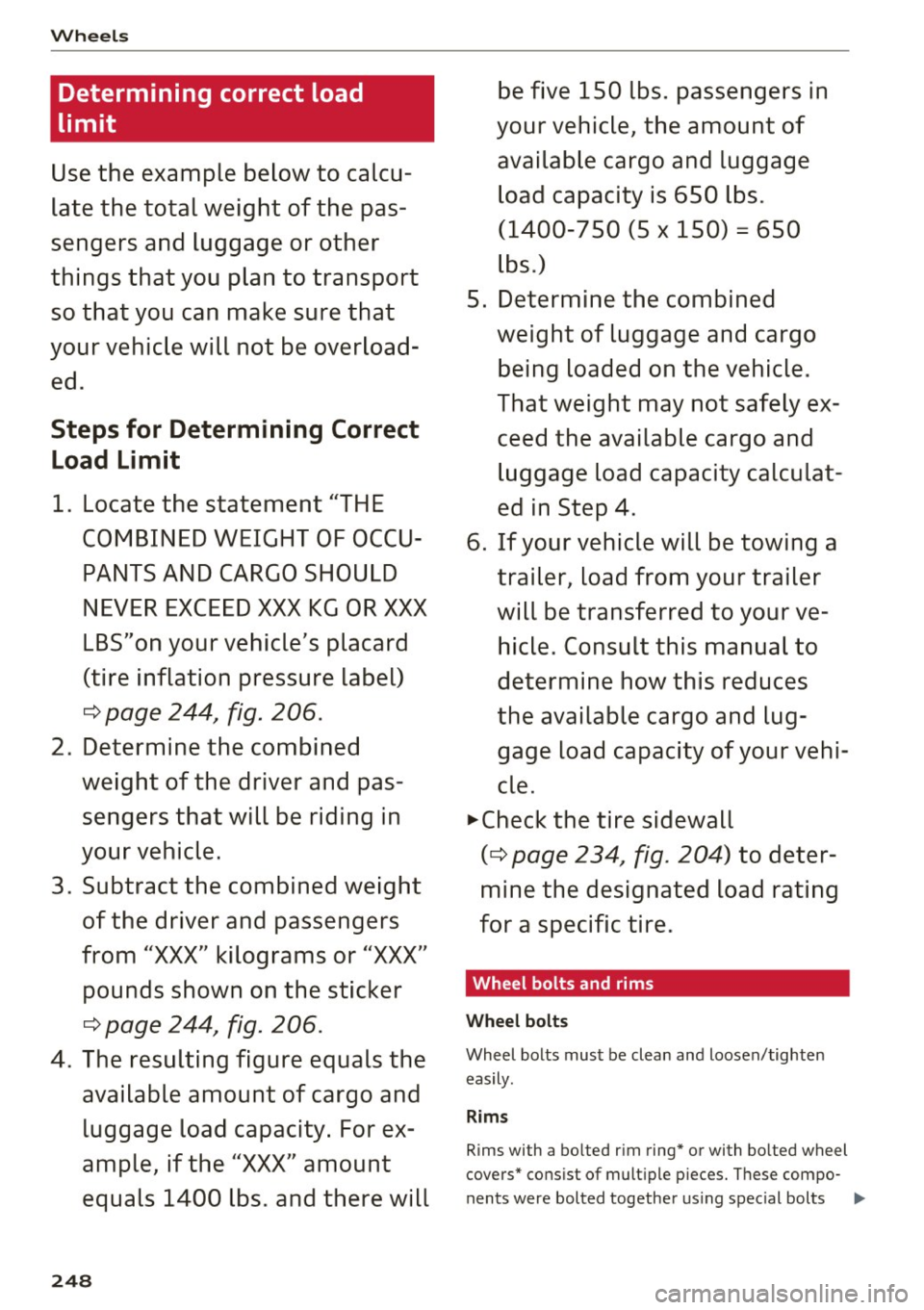
Wheels
Determining correct load
limit
Use the example below to calcu
late the total weight of the pas
sengers and luggage or other
things that you plan to transport so that you can make sure that
your vehicle will not be overload ed .
Steps for Determining Correct
Load Limit
1 . Locate the statement "THE
COMBINED WEIGHT OF OCCU PANTS AND CARGO SHOULD
NEVER EXCEED XXX KG OR XXX
LBS"on your vehicle 's placard
(tire inflation pre ssure label)
c:::> page 244, fig. 206.
2. Determine the combined
weight of the driver and pas
sengers that will be riding in
your vehicle.
3 . Subtra ct the combined weight
of the driver and passengers
from
"XXX" kilograms or " XXX"
pounds shown on the sticker
c:::> page 244 , fig. 206 .
4. The re sulting figure equals the
available amount of cargo and luggage load capacity. For ex
ample, if the
"XXX" amount
equals 1400 lbs. and there will
248
be five 150 lbs. passengers in
your vehicle, the amount of available cargo and luggage load capacity is 650 lb s.
(1400-750 (5 X 150) = 650
lb s.)
5. Determine the combined weight of luggage and cargo
being loaded on the vehicle.
That weight may not safely ex
ceed the available cargo and luggage load capacity calculat
ed in Step 4 .
6. If your vehicle will be towing a trailer, load from your trailer
will be transferred to your ve
hicle. Con sult this manual to
determine how this reduces
the available cargo and lug gage load capacity of your vehi
cle .
~check the tire sidewall
(¢ page 234, fig. 204) to deter
mine the designated load rating
for a specific tire.
· Wheel bolts and rims
Wheel bolts
W heel bolts mus t be clean and loose n/tighten
eas ily.
Rims
R ims with a bo lted r im ring * or with bo lted wheel
covers" co nsist of mult ip le p ieces . T h ese compo-
n ents were bolted togethe r usin g s pec ial bolts ..,.